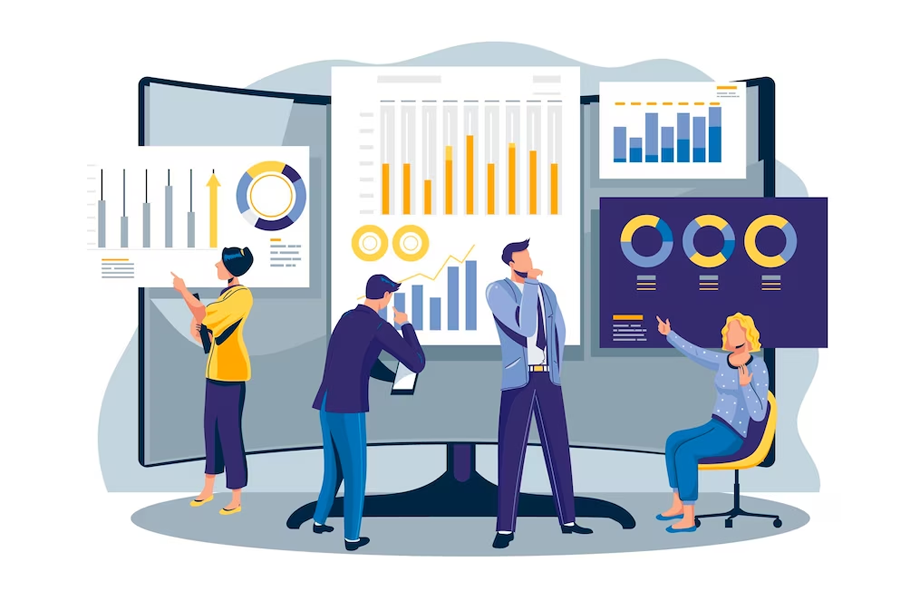Do you want to be a tech-savvy e-commerce business owner? That all starts with understanding how your website works.
This article will tackle some of the most common metrics you’ll find when running your website: visits vs. unique visitors.
We’ll learn the difference between unique visitors and visits, discuss why these metrics are important, and gain some insider insights to help you run a better online store in the Philippines.
Ready to boost your e-commerce knowledge? Dive right in!

What are Website Visits?
When running an e-commerce store, you’ll frequently see the website visits metric whenever you look at analytics of any kind.
But what are website visits, why are they important, and how can you use it for your business?
This section will give you the knowledge you need to maximize this metric for your e-commerce.

Definition of Visits
Website visits refer to when a user visits and views a particular webpage on the internet using a web browser. Whenever a user opens your e-commerce website page, it’s counted as a visit.
Website visits are commonly tracked and measured to analyze a website’s popularity, traffic, and user engagement.
This metric helps website owners and marketers understand how many people interact with their online content. It’s critical for e-commerce because it gives webmasters insights into the level of online attention their website receives.
They can then use this information for different things, such as assessing the effectiveness of digital marketing strategies, optimizing their website content, and crafting campaigns.
Understanding the Concept of Sessions
A core component of the website visit metric is the session. In e-commerce, you look at sessions to see the overall user experience.
For example, if users only have extremely short sessions on a particular page, you’ll want to look at why. It could be that the page is terribly designed, or maybe it didn’t contain what the linking CTA promised.
Definition of a Session
In web analytics, a session is a time period during which a user interacts with a website.
It starts when a user enters the site or app and ends when there is a period of inactivity or when the user leaves. Thus, the same visitor could log several visits depending on how many times they open and close your web page.
Sessions help track and measure user engagement on a digital platform. They’re often used to analyze website performance, user behavior, and overall engagement.
Factors Affecting Session Duration
How long a user stays and interacts with your site can tell you a lot of useful things for improving your website or marketing campaign.
Here are the top three factors to consider when measuring session duration:
- Content relevance and quality. Users are more likely to stay on a website if the content is relevant, informative, and meets their expectations. If you don’t find what you’re looking for, you’ll just likely click off.
- Website navigation. Intuitive and user-friendly navigation makes for longer sessions because websites with clear menus, easy-to-find information, and a logical flow make it convenient for users to explore multiple pages.
- Page load speed. Slow-loading pages can lead to frustration and increased bounce rates, affecting session duration. According to Think With Google, the bounce rate increases by 32% as page load time approaches 3 seconds.
It’s important to note that these factors are interconnected, and addressing them collectively contributes to a more positive user experience than addressing them individually.
Improved content relevance, better website navigation, and enhanced page load speed all encourage users to spend more time on your website.
Measurement of Visits
E-commerce businesses should measure the number of visits because it provides critical insights into the level of online traffic that their site gets. In other words, it helps you determine the popularity of your website.
How can you measure multiple visits to the same site? This section will tell you everything you need to know.
Tracking Tools and Technologies
Several tracking tools and technologies are available for measuring website visits. Some popular ones include Google Analytics, Hotjar, Crazy Egg, and more.
Depending on your analytics needs and business goals, you should choose website analytics subscriptions that suit you. There are free versions, like Google Analytics’s freemium model, but paid subscriptions go into much more detail. Do your research and choose wisely.
Metrics Used to Measure Visits
Aside from the raw numbers of website visits, e-commerce websites also look at other key metrics to gain a more thorough picture of user behavior and website performance.
The top three additional metrics often used for this are the following:
- Bounce rate. This represents the percentage of single-page view visits where users leave the site without interacting further. A high bounce rate may indicate that visitors are not finding what they are looking for or that the landing page needs improvement.
- Average session duration. Essentially, this is how long your visitors typically stay on your pages. A longer average session duration generally suggests higher user engagement, while a shorter duration may indicate that users don’t like what they see.
- Pages per session. This is the number of pages a user views during a visit to your website. Higher numbers indicate exploration, while lower numbers suggest that users find the pages interesting, so they’re not leaving.
These additional metrics help you create a better picture of how your website is performing. Beyond the numbers, it tells you the quality of the user interactions that your pages are getting and helps you make informed strategic decisions to drive better results.
Importance of Tracking Visits
Great, now you know what website visits are and how they affect your website. But really, what are they for?
Let’s look at a few key points why you should be tracking visits:
- Analyzing traffic patterns and trends. By learning your visitor’s behavior, you understand how users interact with your site, helping you tailor every aspect of your digital presence to their preferences.
- Assessing website performance. Tracking visits helps with the effectiveness of marketing strategies, site design, and overall user experience.
- Identifying popular pages and content. Knowing what’s clicking with your audience gives you great insights into what content strategy. With this knowledge, you know what’s working and what’s not, and it allows you to maximize your resources on strategies that give results.
Tracking visits is crucial for you to make a data-driven approach to your website. Without this kind of knowledge, you would essentially be flying blind. You won’t know what’s working and what’s merely bleeding money, what’s sticking to your audience, and what’s forgettable.
Website visits are crucial if you want to take your e-commerce presence seriously.
Factors Influencing Visits
Understanding the factors that affect your site visits is critical. It lets you identify what aspects of your website attract and retain visitors, helps you develop effective marketing strategies, and ensures that the content presented to your audience is ever-relevant.
Here are a few of the most important factors that affect site visits:
- Marketing and advertising campaigns. Well-executed campaigns, whether on social media, email, or other platforms, can generate awareness and interest that prompts users to visit your website.
- Search engine optimization (SEO) strategies. Effective SEO implementation results in higher rankings, making your website more accessible to users searching for relevant information.
- Referral traffic and backlinks. Quality backlinks and referrals from reputable sources significantly boost website visits. They act as endorsements and signal to search engines that your content is valuable and trustworthy.
Several factors significantly affect website visits. Marketing and advertising campaigns drive direct user engagement, SEO strategies enhance visibility in search results, and referral traffic and backlinks contribute to credibility and increased visibility.
What are Website Unique Visitors
Unique visitors refer to individual users who access a website within a specified time period, typically within a 24-hour day or a 30-day month. Tracking unique visitors is valuable for analyzing the growth and popularity of a website over time.
Learn more about unique visitors below.

Definition of Unique Visitors
Contrary to website visits, which are counted in sessions, a unique visitor is just that – a unique user. The term “unique” emphasizes that each visitor is counted only once, regardless of how many times they visit the site during the specified timeframe.
Thus, no matter how many sessions a user makes, if it comes from the same browser or the same IP address, it will only be counted as one.
Differentiating Unique Visitors from Visits
Compared to website visits, the unique visitor metric counts something that uniquely identifies an individual from another. This is the primary difference between the unique visitor metric and the website visit metric, but there are still more differences.
Learning the fine differences between them allows you to get to know both metrics and further guides you to use them for specific purposes on your website.
How Unique Visitors are Identified
Unique visitors are identified through various methods, primarily relying on information collected from users’ devices and browsers. They are identified using various methods such as IP addresses, cookies, user agents, and registration IDs.
The calculation of unique visitors can vary slightly between analytics tools. Some methods might also only work with one browser. This leads to discrepancies in the reported numbers, so it’s important to consider your accuracy needs when implementing solutions.
Tracking Methods for Unique Visitors
How can e-commerce businesses like yours track unique visitors to their websites? Fortunately, gone were the days when website owners coded everything themselves – there are tons of plug-and-play solutions that you can easily implement.
You can use various analytics tools such as Google Analytics, SimilarWeb, and Insider.
In Google Analytics, the Unique Visitors metric can be found in the Audience Overview report, and it counts the number of unique visitors who have visited the website within a specific period.
Other analytics tools use similar methods, such as cookies, IP addresses, user agents, and registration IDs, to identify unique visitors.
Significance of Unique Visitors
The unique visitor metric can evaluate user engagement by providing insights into the number of individual users who visit a website over a specific period.
Here’s how it contributes to assessing user engagement and why it’s important:
- Assessing reach and audience size. This metric can gauge the actual size of your audience. This helps you understand the reach of your e-commerce site and assess its popularity within a specific timeframe.
- Evaluating user engagement. The ability to measure unique visitors ensures you can distinguish between a high volume of visits from a few users versus a broader audience, helping optimize content and features for better engagement.
- Measuring return customers. Tracking unique visitors over time helps businesses identify returning visitors. Understanding user retention rates is crucial for building customer loyalty and implementing strategies to encourage repeat visits and purchases.
This metric is a useful tool that can help you improve your marketing efforts and even optimize your website content. But that’s only if you know how to use it right, which we’ll tackle more in the next sections.
Limitations of Unique Visitor Metrics
As useful as it is, the unique visitor metric is not a magic bullet for all your analytics needs. Tracking one unique visitor has limitations.
For example, the metric struggles to recognize a single person using different devices or even different browsers.
Users who switch between devices (e.g., desktop, mobile, tablet) and between browsers will often appear as multiple unique visitors, leading to overcounting. Other situations, like shared devices or intentionally misleading, can be difficult to catch.
Lastly, increasing privacy concerns might also encourage people to opt out.
While some techniques, like device fingerprinting, aim to address cross-device tracking, they may not always provide accurate identification. Users can still take measures to resist such tracking for privacy reasons.

Factors Affecting Unique Visitor Count
Understanding the factors that can affect the unique visitor count is crucial. If you want to use this metric for your business, then you need to know the levers that move it.
Here are the top three factors:
- Cookie-based tracking. Cookie-based tracking relies on storing small files (cookies) on users’ devices to identify them. If users regularly clear cookies or use incognito mode, cookies won’t be effective as a counting mechanism.
- Privacy regulations and user consent. Privacy regulations, like GDPR, CCPA, or the Cybercrime Prevention Act of 2012 in the Philippines, might require businesses to obtain user consent for data collection. If users refuse consent, it can affect the ability to track them accurately.
- Timeframe for identifying unique visitors. Shorter timeframes, like counting within a day, may capture frequent visitors multiple times, while longer timeframes, like counting within a month, may miss more sporadic users. Choosing the appropriate time frame is crucial for obtaining an accurate, unique visitor count.
Knowing the factors that can affect unique visitor counts empowers businesses to enhance the accuracy of their analytics, make data-driven decisions, and comply with privacy regulations.
Understanding these factors is critical if you want to measure unique visitor counts for your website.
How To Use Your Insights On Visits and Unique Visitors
Learning the difference between website visits and unique visitors is essential if you want to optimize your e-commerce digital strategy.
Analyzing visit data helps businesses understand the overall popularity of their website, the effectiveness of marketing campaigns, and user engagement trends. It guides decisions on content creation, advertising strategies, and website design improvements.
On the other hand, insights into unique visitors offer a more nuanced perspective by distinguishing individual users from repeated visits. This is important for assessing user retention, tailoring personalized experiences, and refining conversion strategies.
Combining these insights enables businesses to identify the most successful marketing channels, directing resources to the most fruitful areas and cutting the rest.
Final Thoughts
If you want your e-commerce business to stand out from your competition in the Philippines, then you need a solid online presence strategy. And the two most important metrics for that are website visits and unique visits.
This article teaches you everything you need to know about these two important measures. Now, you’re prepared to implement them into your digital marketing strategy.
Master your website analytics and watch your audience and sales grow!

Frequently asked questions
What is the difference between visits and unique visitors for an e-commerce website?
Visits represent the total number of times people come to your e-commerce site. On the other hand, unique visitors count each new visitor only once, regardless of how many times they visit. It helps you understand the actual number of different individuals engaging with your online store.
How are visits and unique visitors tracked on an e-commerce website?
Using tools like Google Analytics, page views and unique visitors are tracked on an e-commerce website. Cookies, IP addresses, and login information are common methods to track every new visit. However, they have their own limitations.
What best practices should e-commerce business owners follow when using visits and unique visits as key performance indicators?
E-commerce business owners should focus on accurate tracking methods, choosing appropriate timeframes for analysis, and understanding the factors influencing unique visitor counts.